

Forecasting the future through 'weak signals' Our in-house futurologist explains the importance of so-called 'weak signals' for predicting new trends in technological and social development.

Below is a seemingly random selection of recent news stories: The US Army has shown an interest in regenerative medicine. Established in 2008, the Armed Forces Institute of Regenerative Medicine is a virtual research organisation which brings together more than 20 academic and commercial research institutions devoted to research on the field. The US government has reserved $250m for establishing the institute. The research project focuses on five different areas: burn repair; wound healing without scarring; craniofacial reconstruction; limb reconstruction, regeneration or transplantation; and compartment syndrome, a condition related to inflammation after surgery or injury that can lead to increased pressure, impaired blood flow, nerve damage and muscle death. Future News - What is a Weak Signal? Wednesday 4th of May 2011 by Rafael Popper In recent years, Foresight has emerged as a key instrument for the development and implementation of forward-looking research and innovation policies.
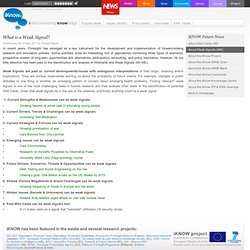
Some activities show an interesting mix of approaches combining three types of elements: prospective studies of long-term opportunities and alternatives, participatory networking, and policy orientation. However, far too little attention has been paid to the identification and analysis of Wildcards and Weak Signals (WI-WE). The strength of ‘weak signals’ As information thunders through the digital economy, it’s easy to miss valuable “weak signals” often hidden amid the noise.
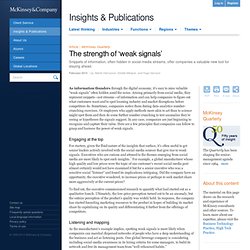
Arising primarily from social media, they represent snippets—not streams—of information and can help companies to figure out what customers want and to spot looming industry and market disruptions before competitors do. Sometimes, companies notice them during data-analytics number-crunching exercises. Or employees who apply methods more akin to art than to science might spot them and then do some further number crunching to test anomalies they’re seeing or hypotheses the signals suggest. In any case, companies are just beginning to recognize and capture their value.
Here are a few principles that companies can follow to grasp and harness the power of weak signals. Engaging at the top To find out, the executive commissioned research to quantify what had started out as a qualitative hunch. 2.9. Foresight and futures studies - 2. 12. Discussion: Innovation processes and creative problem solving processes... 2.9.
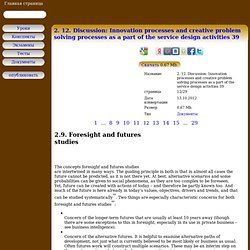
Foresight and futures studies The concepts foresight and futures studies are intertwined in many ways. The guiding principle in both is that in almost all cases the future cannot be predicted, as it is not there yet. At best, alternative scenarios and some probabilities can be given to social phenomena, as they are too complex to be foreseen. Yet, future can be created with actions of today – and therefore be partly known too. Concern of the longer-term futures that are usually at least 10 years away (though there are some exceptions to this in foresight, especially in its use in private business – see business intelligence). On the other hand, foresight and futures studies have several things in contrast too. 2.10. Weak signal is an anomaly in the known transformation. We can say that weak signals are observations or strange ideas that someone has subjectively reasoned to have some special foresight value.
'Look for weak signals of the future, especially when they impose a fear on us' - Interview with Jacintha Scheerder. Jacintha Scheerder, projectleader Horizonscan 2050.
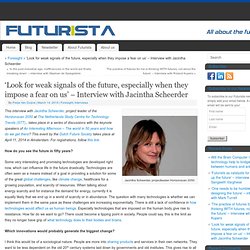
This interview with Jacintha Scheerder, project leader of the Horizonscan 2050 at The Netherlands Study Centre for Technology Trends (STT)., takes place in a series of discussions with the keynote speakers of An Interesting Afternoon – The world in 50 years and how do we get there? This event by the Dutch Future Society takes place at April 11, 2014 in Amsterdam. For registrations, follow this link. How do you see the future in fifty years?
Some very interesting and promising technologies are developed right now, which can influence life in the future drastically. Which innovations would probably generate the biggest change? I think this would be of a sociological nature. Technology plays an important role in facilitating this trend. What can we do to anticipate the future and make it a better future? We need to stay open-minded and constantly look out of the box. What does it ask from futurists? Predictions are often wrong. Future of Research Management: Weak Signals » Foresight Alliance. Image: Croasmun AndSpace Consulting and Foresight Alliance have completed a Weak Signals Report for the Industrial Research Institute, identifying 23 “new patterns of emergent change” that will impact research management over the next 25 years.
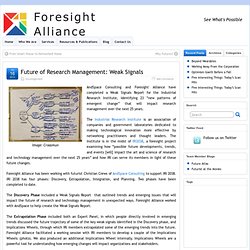
The Industrial Research Institute is an association of companies and government laboratories dedicated to making technological innovation more effective by networking practitioners and thought leaders. The Institute is in the midst of IRI2038, a foresight project examining how “possible future developments, trends, and events [will] impact the art and science of research and technology management over the next 25 years” and how IRI can serve its members in light of these future changes. Foresight Alliance has been working with futurist Christian Crews of AndSpace Consulting to support IRI 2038. IRI 2038 has four phases: Discovery, Extrapolation, Integration, and Planning.